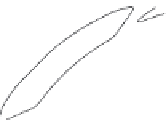Geoscience Reference
In-Depth Information
continuous around the globe (see
Figure 7.13
)
and poleward upper flow occurs mainly at the
western ends of the subtropical high pressure cells
aloft (see
Figures 7.4
and
7.10
).
Figure 7.18
shows another thermally direct
(polar) cell in high latitudes with cold, dense air
flowing out from a polar high pressure. The reality
of this is doubtful, but it is in any case of limited
importance to the general circulation in view of
the small mass involved. It is worth noting that
a single direct cell in each hemisphere is not
possible, because the easterly winds near the
surface would slow down the earth's rotation. On
average the atmosphere must rotate with the
earth, requiring a balance between easterly and
westerly winds over the globe.
The mid-latitude
Ferrel cell
in
Figure 7.18
is
thermally indirect and would need to be driven
by the other two. Momentum considerations
indicate the necessity for upper easterlies in such
a scheme, yet aircraft and balloon observations
during the 1930s-1940s demonstrated the exis-
tence of strong westerlies in the upper troposphere
(see A.3, this chapter). Rossby modified the three-
cell model to incorporate this fact, proposing
that westerly momentum was transferred to mid-
latitudes from the upper branches of the cells in
high and low latitudes. Troughs and ridges in the
upper flow could, for example, accomplish such
horizontal mixing.
These views underwent radical amendment
from about 1948 onward. The alternative means
of transporting heat and momentum - by
horizontal circulations - had been suggested in the
1920s by A. Defant and H. Jeffreys but could not
be tested until adequate upper-air data became
available. Calculations for the Northern Hemi-
sphere by V. P. Starr and R. M. White at the
Massachusetts Institute of Technology showed
that in mid-latitudes horizontal cells transport
most of the required heat and momentum pole-
ward. This operates through (1) the mechanism of
the quasi-stationary highs and (2) the traveling
highs and lows near the surface, both acting in
conjunction with their related wave patterns aloft.
The former is referred to as the standing waves
and the latter as transient eddies. The importance
of such horizontal eddies for energy transport is
Polar Cell
(Direct)
SW
NE
Ferrel Cell
(Indirect)
Polar Easterlies
Polar Easterlies
W
SW
Westerlies
Westerlies
NE
NE
Trade Winds
NE
Trade Winds
Hadley Cells
(Direct)
Hadley
Cells
NW
SE
SE
Trade Winds
SE
Trade Winds
Figure 7.18
Schematic
three-cell model of the
meridional circulation and main
wind belts in each hemisphere.
Source: Adapted from NASA.
W
Ferrel Cell
(Indirect)



















































































